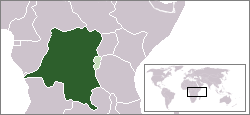
Back الكونغو البلجيكية Arabic Belçika Konqosu Azerbaijani بلژیک کونقوسو AZB Бельгійскае Конга Byelorussian Белгийско Конго Bulgarian Belgické Kongo Czech Belgisk Congo Danish Geschichte der Demokratischen Republik Kongo#Belgisch-Kongo German Βελγικό Κονγκό Greek Belga Kongo Esperanto
Belgian Congo | |||||||||
|---|---|---|---|---|---|---|---|---|---|
| 1908–1960 | |||||||||
| Motto: Travail et Progrès - L'union fait la force "Work and Progress - Unity Makes Strength" | |||||||||
| Anthems: La Brabançonne ("The Brabantian") Vers l'avenir[1] ("Towards the future") | |||||||||
 The Belgian Congo (dark green) shown alongside Ruanda-Urundi (light green), 1935 | |||||||||
| Status | Colony of Belgium | ||||||||
| Capital | Boma (1908–1923) Léopoldville (1923–1960) 04°18′24″S 15°16′49″E / 4.30667°S 15.28028°E | ||||||||
| Common languages | |||||||||
| Religion | Roman Catholicism (de facto)[5] | ||||||||
| Government | Colonial administration | ||||||||
| King | |||||||||
• 1908–1909 | Leopold II | ||||||||
• 1909–1934 | Albert I | ||||||||
• 1934–1951 | Leopold III | ||||||||
• 1951–1960 | Baudouin | ||||||||
| Governor-General | |||||||||
• 1908–1912 (first) | Théophile Wahis | ||||||||
• 1958–1960 (last) | Hendrik Cornelis | ||||||||
| History | |||||||||
| 15 November 1908 | |||||||||
| 30 June 1960 | |||||||||
| Currency | Belgian Congo franc | ||||||||
| |||||||||
| Today part of | Democratic Republic of the Congo | ||||||||
| History of the Democratic Republic of the Congo | ||||||||||||||||
|---|---|---|---|---|---|---|---|---|---|---|---|---|---|---|---|---|
 | ||||||||||||||||
|
||||||||||||||||
|
||||||||||||||||
|
||||||||||||||||
| See also: Years | ||||||||||||||||
|
| ||||||||||||||||
The Belgian Congo (French: Congo belge, pronounced [kɔ̃ɡo bɛlʒ]; Dutch: Belgisch-Congo[a]) was a Belgian colony in Central Africa from 1908 until independence in 1960 and became the Republic of the Congo (Léopoldville). The former colony adopted its present name, the Democratic Republic of the Congo (DRC), in 1964.
Colonial rule in the Congo began in the late 19th century. King Leopold II of the Belgians attempted to persuade the Belgian government to support colonial expansion around the then-largely unexploited Congo Basin. Their ambivalence resulted in Leopold's establishing a colony himself. With support from a number of Western countries, Leopold achieved international recognition of the Congo Free State in 1885.[7] By the turn of the century, the violence used by Free State officials against indigenous Congolese and a ruthless system of economic exploitation led to intense diplomatic pressure on Belgium to take official control of the country, which it did by creating the Belgian Congo in 1908.[8]
Belgian rule in the Congo was based on the "colonial trinity" (trinité coloniale) of state, missionary and private-company interests.[9] The privileging of Belgian commercial interests meant that large amounts of capital flowed into the Congo and that individual regions became specialised. On many occasions, the interests of the government and of private enterprise became closely linked, and the state helped companies to break strikes and to remove other barriers raised by the indigenous population.[9] The colony was divided into hierarchically organised administrative subdivisions and run uniformly according to a set "native policy" (politique indigène). This differed from the practice of British and French colonial policy, which generally favoured systems of indirect rule, retaining traditional leaders in positions of authority under colonial oversight.[clarification needed]
During the 1940s and 1950s, the Belgian Congo experienced extensive urbanisation and the colonial administration began various development programs aimed at making the territory into a "model colony".[10] One result saw the development of a new middle-class of Europeanised African "évolués" in the cities.[10] By the 1950s, the Congo had a wage labour force twice as large as that in any other African colony.[11]
In 1960, as the result of a widespread and increasingly radical pro-independence movement, the Belgian Congo achieved independence, becoming the Republic of the Congo under Prime Minister Patrice Lumumba and President Joseph Kasa-Vubu. Poor relations between political factions within the Congo, the continued involvement of Belgium in Congolese affairs, and the intervention by major parties (mainly the United States and the Soviet Union) during the Cold War led to a five-year-long period of war and political instability, known as the Congo Crisis, from 1960 to 1965. This ended with the seizure of power by Joseph-Désiré Mobutu in November 1964.
- ^ "IL PEUT LE DIRE". Le Soir Plus (in French). Archived from the original on 5 September 2021. Retrieved 5 September 2021.
- ^ "Self-Access Centre Database". resources.clie.ucl.ac.uk. Archived from the original on 26 July 2020. Retrieved 26 January 2020.
- ^ (in French) République démocratique du Congo Archived 27 November 2012 at the Wayback Machine, Université Laval, Canada
- ^ (in Dutch) Vlamingen en Afrikanen—Vlamingen in Centraal Afrika Archived 11 July 2016 at the Wayback Machine, Faculteit Sociale Wetenschappen, KU Leuven, Belgium
- ^ Kasongo, Michael (1998). History of the Methodist Church in the Central Congo. University Press of America. ISBN 9780761808824. Archived from the original on 20 December 2021. Retrieved 8 November 2020.
- ^ Kongo-overzee: tijdschrift voor en over Belgisch-Kongo en andere overzeese gewesten Archived 26 July 2020 at the Wayback Machine, Volume 25, De Sikkel, 1959
- ^ Pakenham 1992, pp. 253–5.
- ^ Pakenham 1992, pp. 588–9.
- ^ a b Turner 2007, p. 28.
- ^ a b Freund 1998, pp. 198–9.
- ^ Freund 1998, p. 198.
Cite error: There are <ref group=lower-alpha> tags or {{efn}} templates on this page, but the references will not show without a {{reflist|group=lower-alpha}} template or {{notelist}} template (see the help page).
© MMXXIII Rich X Search. We shall prevail. All rights reserved. Rich X Search

